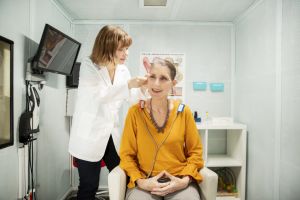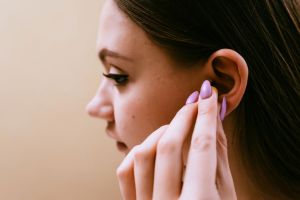Hearing loss is the loss of hearing in one or both ears, ranging from mild to profound. There are many causes, and it can affect anyone at any age, but it’s most common among people older than 60.
How common is it? Statistics show that about 16% of U.S. adults have hearing loss, and it’s twice as common as diabetes or cancer. About one out of 5 men and one out of 8 women report they have at least some trouble hearing.
The good news is that there are numerous solutions, including hearing aids. By learning more about the symptoms, causes, tests, treatments and prevention of hearing loss, it is easier to understand how it impacts you or your loved one—and what you can do about it.

hearing test.
Table of Contents
Symptoms of hearing loss
The symptoms of hearing loss can vary depending on the type of hearing loss, the cause of hearing loss, and the degree of loss.
For people with age-related hearing loss, it’s typical to experience what’s known as high-frequency hearing loss. Higher-pitched sounds, such as women’s voices and birds chirping, may be harder to hear.
But in general, people who have hearing loss may experience any or all of the following:
- Difficulty understanding everyday conversation
- A feeling of being able to hear but not understand
- Having to turn up the TV or radio
- Asking others to repeat often
- Avoidance of social situations that were once enjoyable
- A sense of exhaustion after a day of listening to other people
- Increased difficulty communicating in noisy situations like restaurants, lively family gatherings, in the car or in group meetings
- Tinnitus, or ringing and/or buzzing sounds in the ears
Types of hearing loss

understand conversations in noisy places.
There are three main types of hearing loss:
- Sensorineural hearing loss is the most common type of hearing loss. It is permanent and caused by many different conditions that damage tiny hair-like cells in the inner ear or the auditory nerve. The auditory nerve carries important information about the loudness, pitch and meaning of sounds to the brain. Most adults with hearing loss have a sensorineural loss. Sensorineural hearing loss can often result in difficulty understanding sound or speech even though it is loud enough to hear.
- Conductive hearing loss is caused by a mechanical problem in the outer or middle ear or an obstruction in the ear canal, such as earwax that blocks sound from getting to the eardrum. It can be permanent, but more often it is temporary and can be medically treated.
- Mixed hearing loss is when a person has both sensorineural and conductive hearing loss.
Causes of hearing loss
There are many causes of hearing loss, and it’s important to figure out what is causing the hearing loss to determine the right treatment.
Hearing loss risk factors
Any of the following scenarios increase your risk of developing gradual hearing loss:
- Being over 60 years old, when age-related hearing loss is more likely to occur
- Frequent exposure to excessive noise, such as from loud machinery or gunfire
- Having a close family relative with hearing loss, or a family history of genetic disorders with hearing loss
The more of these risk factors you have, the more likely you will experience hearing loss. Hearing loss is usually gradual. These are the most common risk factors, but there are some surprising risk factors, too.
Less common causes of hearing loss
Meanwhile, hearing loss also can be caused by any of the following conditions:
- Certain medications, sometimes called “ototoxic” drugs
- Trauma or injury to the head
- Certain illnesses such as Meniere’s disease, otosclerosis or autoimmune disease
- Acoustic neuroma
Tests for hearing loss
If you suspect you have a hearing loss, it is important to immediately seek the advice of a qualified hearing healthcare professional, such as an audiologist or hearing instrument specialist. Hearing tests are simple, painless, and widely available. Your hearing health professional will begin by conducting a thorough history, and they will ask questions about the challenges you are having, your lifestyle and your communication needs.
There are different types of hearing tests that evaluate specific parts of the auditory system and specialized hearing tests just for infants and toddlers. However, most hearing tests involve a sound-treated room or booth and headphones. Your hearing care professional will also conduct a visual exam of your ear canals and eardrum using a lighted instrument called an otoscope. This will determine if something physical, such as earwax, is contributing to your hearing loss.
Once in the booth, you will be asked to listen to a variety of tones and indicate the softest tones you can hear by pressing a button. This part of the exam is called pure tone audiometry, and it is valuable for determining not only how much hearing loss you have, but which frequencies are most affected. You may also be asked to listen for and repeat words. These speech tests can determine the softest speech sounds you can hear and how well you can understand speech clearly when it is loud enough for you to hear it.
Hearing tests are simple, painless and widely available.
If the hearing healthcare professional determines it is necessary, you may also be asked to wear plastic or soft foam earplugs during tests for acoustic reflexes. Another test called tympanometry tests the function of your eardrum.
Test results are marked and presented on a graph called an audiogram. An audiogram displays the softest sounds you can hear at different pitches. These results will enable your hearing healthcare provider to assess your hearing ability and develop the right treatment plan if necessary.
Online hearing checks also are available. While online hearing tests cannot replace the thorough test a hearing healthcare professional provides, they can be a good place to start.
Hearing loss treatments
Hearing loss is generally not curable, but it is almost always treatable. Finding the right treatment is a joint venture between you and your hearing care professional, and if done properly, takes into consideration the following factors:
- Type of hearing loss
- Severity of hearing loss
- Cause, if known
- Your lifestyle
- Your age and your communication needs
- Your cosmetic preferences
- Your budget
Hearing aids are the most common treatment for hearing loss.
Some types of hearing loss, especially conductive types, can be medically or surgically corrected but others cannot. The most common treatment for sensorineural hearing loss is properly fitted hearing aids. Hearing aids are widely available in a range of styles, colors, sizes, technology levels, and price points. The great news? They do more than just help you hear—hearing aids will make you healthier overall, too. Increasingly, cochlear implants are a good treatment option for people who aren’t helped enough by hearing aids.
Hearing loss prevention

noisy situations.
Just because hearing loss is common doesn’t mean everyone is destined to be affected by it. There are many ways to prevent hearing loss or stop it from getting worse.
Most importantly, protect yourself against noise-induced hearing loss. Some noisy occupations can increase your risk of developing hearing loss. This cause of hearing loss is the easiest type to prevent by limiting exposure to loud noise and wearing hearing protection.
If you already have hearing loss, prevent it from getting worse by avoiding excessive noise exposure.
Hearing protection generally comes in the form of earplugs, earmuffs or noise-canceling headphones. Earplugs are made of acoustically impenetrable materials. When sized correctly and inserted into the ear, they can provide a good deal of hearing protection. Earmuffs or noise-cancellation earphones are others options for hearing protection. These devices offer greater protection against prolonged or higher levels of noise. These devices work by covering the entire ear to block or cancel out loud noises.
The hidden dangers of untreated hearing loss
Hearing loss can have far-reaching implications for you and those close to you. Untreated hearing loss can impact your health as well as your well-being. Research indicates that people with hearing loss have higher rates of depression, anxiety. It also causes under-stimulation of the brain, known as auditory deprivation.
Medically, people with hearing loss face higher medical costs for other health issues and a higher risk of dangerous trips and falls.
For people still in the workforce, hearing loss is linked to unemployment and lower earnings at work.
More: 7 reasons to stop putting off your hearing health
Fortunately, hearing loss is well-understood and often treatable with hearing aids. By seeking information here, you’ve taken a smart first step.
Children and hearing loss
Hearing loss is harmful to people of all ages, but for children, it has special implications. Because babies and young children need to hear in order to develop spoken language, good hearing is the foundation for spoken communication, social development and educational success.
Most hospitals screen every newborn for potential hearing loss. Those infants identified by the screening are referred for further testing to confirm the presence of hearing loss and gather more information so decisions can be made regarding intervention. If your child has a hearing loss, you are encouraged to talk with a pediatric audiologist. Pediatric audiology is a specialized field of professionals dedicated to the specific needs of babies and children with hearing loss.
Hearing loss in children can be caused by congenital factors, head trauma, medications, childhood illnesses, persistent middle ear infections, deformities of the ear canal or malfunctioning eardrums. Treatment of childhood hearing loss depends largely on the underlying cause. Identification of hearing loss and intervention prior to 6 months of age has been shown to dramatically improve outcomes for kids.
What’s next?
Pat yourself on the back for taking this very important first step to learning about hearing loss. We know that if you have hearing loss or if someone close to you is affected, the feeling can be overwhelming and maybe a little confusing. That’s why we invite you to take a deeper dive by exploring the information here until you are ready to seek help.
Our directory of consumer-viewed hearing clinics is a good place to find a hearing care professional, such as an audiologist or hearing instrument specialist.


